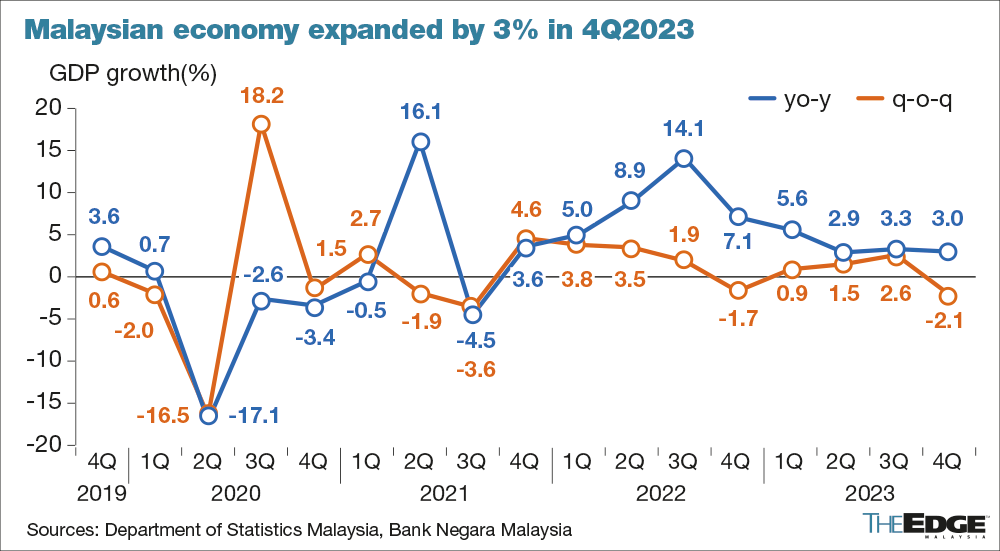_ZHD_5658%20BNM_20240124145451_theedgemalaysia_1.jpg&w=1920&q=75)
KUALA LUMPUR (Feb 16): Malaysia’s economy expanded slightly slower than expected in the fourth quarter of 2023 (4Q2023) as resilient household spending and investment activities cushioned subdued exports.
Gross domestic product (GDP) grew 3% year-on-year (y-o-y) in October-December 2023 when compared to the same period in 2022, Bank Negara Malaysia announced on Friday. The reading is a tad lower than both Bloomberg and Reuters surveys of economists which predicted a median 3.4% y-o-y rise.
“Moving forward, Malaysia’s growth [will] improve due to resilient domestic expenditure and recovery in external demand,” Bank Negara Malaysia said in a statement. “Together with the tech upcycle, the stronger external demand and continued improvement in the tourism sector will provide support to Malaysia’s exports.”
In 3Q2023, GDP rose 3.3%. On a seasonally-adjusted basis, 4Q2023 GDP fell 2.1% from the third quarter of 2023.
Economists said Malaysia’s trade-dependent economy remained exposed to external risks even as domestic demand stayed resilient.
“Malaysian economy is an open economy and therefore, any gyration in the external demand will be effectively transmitted to our exports and the manufacturing sector,” said Bank Muamalat Malaysia Bhd chief economist Dr Mohd Afzanizam Abdul Rashid. “Domestic demand will be [the] key underpinning factor that will ensure the Malaysian overall growth will remain fairly stable.”
On the demand side, private consumption rose 4.2% while private investment climbed 4.0%, data out earlier showed. Public consumption gained 7.3% and public investment surged 11.3%. Net exports contracted 35.6%.
On the supply side, the services sector expanded 4.2% while the key manufacturing sector shrank 0.3%. Mining output edged up 3.8% while the construction sector was 3.6% higher.
For the full year, the third-largest Southeast Asian economy grew 3.7% compared to official estimates of between 4% and 5% and 2022’s 8.7% growth.
This year, the government forecasts the economy to pick up pace to 4%-5%.
While the overall growth outlook for 2024 is positive, the road ahead could be bumpy, especially in the first half, due to geopolitical uncertainties, said UOB senior economist Julia Goh.
The second-half, however, could see “a more meaningful pick-up” due to easing global interest rates and turnaround in the global trade cycle while domestic investment projects, higher development spending and tourism recovery could provide support, she added.

